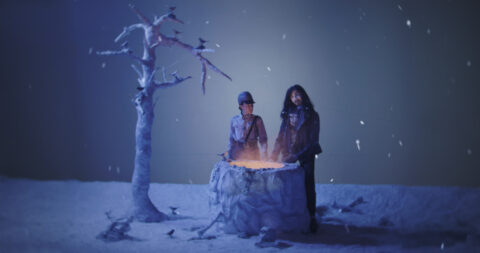It’s telling that The Hyperboreans (Cristobal León and Joaquín Cociña, 2024) opens with a television. Right from the beginning of this dazzling metafiction, the filmmakers, opening upon a washed-out, blurry, monochrome screen, seem obsessed with the power of images, and how the manner of telling is just as important as the telling itself. This collagistic fairy tale is infused with the spirit of Carl Jung and the occult, utilising stop-motion cinema, Brechtian theatre and the silent tradition to investigate the disturbing legacy of Nazism in Chile.
Antonia Giesen stars as herself, an actress/psychologist with both German and Chilean heritage. She directly addresses the camera, telling the story of a lost film shot on celluloid that this new movie seeks to reimagine. It’s mostly set in an artist’s gallery cum warehouse, where the sets are constantly moving in and out of the frame, creating an ever-shifting sense of dislocation as Giesen descends into a bizarro world composed entirely of cinematic form itself.
Things take a decidedly left turn when her patient Metalhead (Francisco Visceral Rivera) appears to be speaking through the soul of occult Chilean Nazi Miguel Serrano. Alongside Savitri Devi, he was one of the most prominent exponents of Estoteric Hitlerism, espousing the wacko idea that Hitler descended from a god-like race known as the hyperboreans. Not only did the Fuhrer survive the end of WW2, but escaped to Antarctica! Unfortunately, his ideas were not just far-fetched nonsense but formed the basis of the Chilean neo-Nazi movement. As Giesen learns more about this dark side of Chilean history, the story becomes more and more untethered, foregoing any sense of conventional narrative in favour of a nightmarish vision of a nation off its rocker.
With just a small amount of post-movie Googling, I felt I learned more about 20th-century Chile than any documentary of the same length could ever achieve. This is hardly ancient history either; not only did Serrano die in 2009, but he was bestowed with a lifetime achievement award in 2008 by the Universidad Mayor in Santiago. And in 2014, a petition by the historian Rafael Videla Eissman to commemorate Serrano with a plaque was thankfully rejected by the same city council. You’d think his ideas would be consigned to the dustbin. Sadly, his lingering influence on 21st-century anti-Semitism and Nazism (both local and abroad) is substantial.
Given the weightiness of the subject matter, it could’ve been easy for this dense tale to come across as too academic, but there’s a real charm in the transitions, the handmade set designs, the use of papier-mâché and puppetry, and the spontaneous-feeling camera movements. The nakedly metafictional moments rarely come off as affected, but handmade and lovingly crafted, taking a deep joy in the malleability of cinematic forms. Whether it’s iris shots, tinted monochrome, whip pans, slow zooms, close-ups or jump cuts, Leon and Cociña use the full toolkit of movie-making tricks to bring their vision to life.
I loved one tracking shot in particular, with the camera keeping the dolly track in the frame itself, replete with whirring sound design; showing us the guts of the filmmaking process while slowly immersing us into the dream-like mind of the protagonist.
The punky spirit of Radu Jude comes to mind, particularly his under-appreciated, formally rigorous historical examination of Uppercase Print (2020) or the metafictional start of I Do Not Care If We Go Down in History As Barbarians (2018), as well as Guy Maddin’s re-interpretations and imaginations of silent cinema and Wes Anderson’s flair for dioramas.
One contemporaneous Chilean work might be El Conde (Pablo Larraín, 2023), which used the vampire genre to analyse the particular soul-sucking evil of Pinochet’s regime. But while El Conde felt classical in its compositions, courtesy of Ed Lachman’s gorgeous black-and-white photography, The Hyperboreans has a more anarchistic feel, piling ideas on top of each other at an alarming, indigestible rate. This is a bizarre, disturbing and deeply entertaining work of art.

Redmond is the editor-in-chief of Journey Into Cinema.
